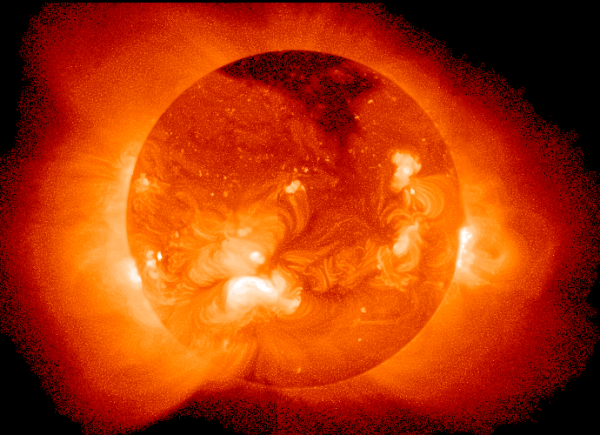Scientists Find New Clues on the Solar Cycle
| Marc Maligalig | | Sep 04, 2014 09:09 AM EDT |
(Photo : Wikimedia Commons)
Scott McIntosh, a space scientist at the National Center for Atmospheric Research in Boulder, CO and his colleagues have discovered a new marker, named brightpoints, to observe in order to track the constant shifting of elements inside the sun.
The sun changes its habits from calm and quiet to violently active about every 11 years. The Solar maximum, the peak of the star's activity, is a period of several sunspots interspersed with prominent eruptions that send out solar particles and radiation into space.
Like Us on Facebook
The duration of the solar cycle, however, is far from exact. It was in the 17th century that humans began regularly taking note of the sunspots. Data collected show that the length of time between consecutive solar maxima could be as long as 14 years, but as short as nine, which makes it difficult to find the cause of the events.
The brightpoints, which are small bright patches in the Sun's atmosphere, provide a new method to observe how the magnetic fields move and evolve through the star. The new information collected by the team suggest that established theories on the solar cycle might require significant edits.
In the past centuries, the accumulated data on the presence of sunspots in the star's atmosphere was the sole set of observations used in the past to formulate the theories on what happens inside the sun that generates the irregular cycle. Over the past few decades, scientists were able to add data about magnetic measurements of the sun from a distance of over 90 million miles away as they figured out that the sunspots were regions of intense magnetic fields.
"Sunspots have been the perennial marker for understanding the mechanisms that rule the sun's interior," McIntosh said. "But the processes that make sunspots are not well understood, and far less, those that govern their migration and what drives their movement. Now we can see there are bright points in the solar atmosphere, which act like buoys anchored to what's going on much deeper down. They help us develop a different picture of the interior of the sun."
TagsScience, Research, Sun, Galaxy, solar system, solar power
©2015 Chinatopix All rights reserved. Do not reproduce without permission
EDITOR'S PICKS
-

Did the Trump administration just announce plans for a trade war with ‘hostile’ China and Russia?
-

US Senate passes Taiwan travel bill slammed by China
-

As Yan Sihong’s family grieves, here are other Chinese students who went missing abroad. Some have never been found
-

Beijing blasts Western critics who ‘smear China’ with the term sharp power
-

China Envoy Seeks to Defuse Tensions With U.S. as a Trade War Brews
-

Singapore's Deputy PM Provides Bitcoin Vote of Confidence Amid China's Blanket Bans
-

China warns investors over risks in overseas virtual currency trading
-

Chinese government most trustworthy: survey
-

Kashima Antlers On Course For Back-To-Back Titles
MOST POPULAR
LATEST NEWS
Zhou Yongkang: China's Former Security Chief Sentenced to Life in Prison

China's former Chief of the Ministry of Public Security, Zhou Yongkang, has been given a life sentence after he was found guilty of abusing his office, bribery and deliberately ... Full Article
TRENDING STORY

China Pork Prices Expected to Stabilize As The Supplies Recover

Elephone P9000 Smartphone is now on Sale on Amazon India

There's a Big Chance Cliffhangers Won't Still Be Resolved When Grey's Anatomy Season 13 Returns

Supreme Court Ruled on Samsung vs Apple Dispute for Patent Infringement

Microsoft Surface Pro 5 Rumors and Release Date: What is the Latest?










